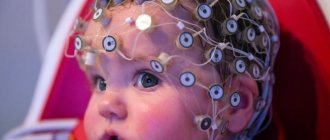Dementia in children and young people is an acquired dementia, which is accompanied by the loss of already developed intelligence. With this disease, brain tissue is damaged, as a result of which memory, speech, analytical and cognitive abilities, and motor skills are impaired. It is customary to talk about acquired dementia in children when the child reaches 2-3 years of age, when behavior can reveal noticeable deviations from normal mental development. Overt, progressive dementia is most often observed in children after 15 years of age, when the biological maturation of the brain ends.
SIGNS
First of all, it is worth noting that mental retardation is not a disease from which one can be cured. This condition is caused by irreversible changes in the cerebral cortex during the formation of the nervous system in the perinatal period. The main actions of doctors and other specialists will be aimed at socializing such a child in society and teaching him the simplest skills.
Signs of mental retardation in children:
- low level of cognitive activity. The child simply does not understand why he needs to learn something, and therefore does not want to make efforts in this direction;
- motor skills practically do not develop;
- significant delay in speech development, small vocabulary. The child cannot form sentences and pronounces words incorrectly;
- lack of abstract thinking, inability to perform even the simplest logical operations, thought processes are slow or completely absent;
- the child plays the simplest games because he can only imitate those around him. Such a child chooses work that is very easy, since it does not require volitional effort;
- mood can fluctuate sharply for no particular reason, excitability can be both quite high and low;
- the child perceives the world around him with significant difficulties; he is not able to navigate in space. Such children are not able to understand the process of forming a whole from individual parts and cannot determine the main thing;
- concentration of attention is short, switching from one type of activity to another occurs very slowly.
Children with such deviations are characterized by voluntary memory; they usually focus on the external features of an object rather than on its internal features.
Signs of mental retardation in children can appear immediately after birth, but most often this pathology is detected after 3 years. The time of diagnosis largely depends on the severity of the condition: the more significant the damage to the central nervous system, the earlier the symptoms of mental retardation will be noticeable.
Dementia
Dementia is a severe disorder of higher nervous activity caused by organic damage to the brain, and is manifested, first of all, by a sharp decrease in mental abilities (hence the name - dementia translated from Latin means feeble-mindedness). The clinical picture of dementia depends on the cause that caused organic brain damage, on the localization and extent of the defect, as well as on the initial state of the body. However, all cases of dementia are characterized by pronounced stable disorders of higher intellectual activity (memory deterioration, decreased ability to abstract thinking, creativity and learning), as well as more or less pronounced disturbances of the emotional-volitional sphere, from the accentuation of character traits (the so-called “caricature”) until the complete collapse of personality. Causes and types of dementia
Since the morphological basis of dementia is severe organic damage to the central nervous system, the cause of this pathology can be any disease that can cause degeneration and death of cells in the cerebral cortex. First of all, it is necessary to highlight specific types of dementia in which destruction of the cerebral cortex is an independent and leading pathogenetic mechanism of the disease:
· Alzheimer's disease;
Dementia with Lewy bodies;
· Pick's disease, etc.
In other cases, damage to the central nervous system is secondary and is a complication of the underlying disease (chronic vascular pathology, infection, trauma, intoxication, systemic damage to nervous tissue, etc.). The most common cause of secondary organic brain damage is vascular disorders, in particular cerebral atherosclerosis and hypertension. Common causes of dementia also include alcoholism, tumors of the central nervous system, and traumatic brain injury. Less commonly, the cause of dementia is infections - AIDS, viral encephalitis, neurosyphilis, chronic meningitis, etc. In addition, dementia can develop:
as a complication of hemodialysis;
· as a complication of severe renal and liver failure;
· for some endocrine pathologies (thyroid disease, Cushing's syndrome, pathology of the parathyroid glands);
· for severe autoimmune diseases (systemic lupus erythematosus, multiple sclerosis).
In some cases, dementia develops from multiple causes. A classic example of such a pathology is senile (senile) mixed dementia. Functional and anatomical types of dementia
Depending on the predominant localization of the organic defect, which has become the morphological substrate of the pathology, four types of dementia are distinguished: 1. Cortical dementia - predominant damage to the cerebral cortex. This type is most typical for Alzheimer's disease, alcoholic dementia, and Pick's disease. 2. Subcortical dementia. With this type of pathology, the subcortical structures are primarily affected, which causes neurological symptoms. A typical example is Parkinson's disease with predominant damage to the neurons of the substantia nigra of the midbrain, and specific motor disorders: tremor, general muscle stiffness (“doll gait”, mask-like face, etc.). 3. Cortical-subcortical dementia is a mixed type of lesion, characteristic of pathology caused by vascular disorders. 4. Multifocal dementia is a pathology characterized by multiple lesions in all parts of the central nervous system. Steadily progressing dementia is accompanied by severe and varied neurological symptoms. Forms of dementia
Clinically, lacunar and total forms of dementia are distinguished. Lacunarnaya
Lacunar dementia is characterized by peculiar isolated lesions of the structures responsible for intellectual activity. In this case, as a rule, short-term memory suffers the most, so patients are forced to constantly take notes on paper. Based on its most pronounced symptom, this form of dementia is often called dysmnestic dementia (dysmensia literally means memory impairment). However, a critical attitude towards one’s condition remains, and the emotional-volitional sphere suffers slightly (most often only asthenic symptoms are expressed - emotional lability, tearfulness, increased sensitivity). A typical example of lacunar dementia is the initial stages of the most common form of dementia, Alzheimer's disease. Total
Total dementia is characterized by complete disintegration of the core of personality. In addition to pronounced violations of the intellectual-cognitive sphere, gross changes in emotional-volitional activity are observed - a complete devaluation of all spiritual values occurs, as a result of which vital interests become impoverished, the sense of duty and modesty disappears, and complete social disadaptation occurs. The morphological substrate of total dementia is damage to the frontal lobes of the cerebral cortex, which often occurs with vascular disorders, atrophic (Pick's disease) and volumetric processes of the corresponding localization (tumors, hematomas, abscesses). Basic classification of presenile and senile dementias
The likelihood of developing dementia increases with age. So if in adulthood the proportion of patients with dementia is less than 1%, then in the age group after 80 years it reaches 20%. Therefore, the classification of dementias that occur at a late age is especially important. There are three types of dementia that are most common in presenile and senile (presenile and senile) ages: 1. Alzheimer's (atrophic) type of dementia, which is based on primary degenerative processes in nerve cells. 2. Vascular type of dementia, in which degeneration of the central nervous system develops secondarily, as a result of severe circulatory disorders in the vessels of the brain. 3. Mixed type, which is characterized by both mechanisms of disease development. Clinical course and prognosis
The clinical course and prognosis of dementia depend on the cause that caused the organic defect of the central nervous system. In cases where the underlying pathology is not prone to development (for example, with post-traumatic dementia), with adequate treatment, significant improvement is possible due to the development of compensatory reactions (other areas of the cerebral cortex take on part of the functions of the affected area). However, the most common types of dementia - Alzheimer's disease and vascular dementia - have a tendency to progress, therefore, when they talk about treatment, for these diseases we are only talking about slowing down the process, social and personal adaptation of the patient, prolonging his life, relieving unpleasant symptoms, etc. .P. And finally, in cases where the disease that causes dementia progresses rapidly, the prognosis is extremely unfavorable: the patient’s death occurs several years or even months after the first signs of the disease appear. The cause of death, as a rule, is various concomitant diseases (pneumonia, sepsis), developing against the background of disturbances in the central regulation of all organs and systems of the body. Severity (stage) of dementia
In accordance with the patient’s social adaptation capabilities, three degrees of dementia are distinguished. In cases where the disease that causes dementia has a steadily progressive course, we often speak of the stage of dementia. Mild degree
With mild dementia, despite significant impairments in the intellectual sphere, the patient remains critical of his own condition. So the patient can easily live independently, performing familiar household activities (cleaning, cooking, etc.). Moderate degree
With moderate dementia, there are more severe intellectual impairments and a reduced critical perception of the disease. At the same time, patients experience difficulties in using ordinary household appliances (stove, washing machine, TV), as well as telephones, door locks and latches, so in no case should the patient be completely left to his own devices. Severe dementia
In severe dementia, a complete breakdown of the personality occurs. Such patients often cannot eat on their own, observe basic hygiene rules, etc. Therefore, in the case of severe dementia, hourly monitoring of the patient is necessary (at home or in a specialized institution). Diagnostics
To date, clear criteria for diagnosing dementia have been developed: 1. Signs of memory impairment - both long-term and short-term (subjective data from a survey of the patient and his relatives are supplemented by objective research). 2. The presence of at least one of the following disorders characteristic of organic dementia:
vsigns of decreased ability for abstract thinking (according to objective research);
vsymptoms of decreased criticality of perception (discovered when making real plans for the next period of life in relation to oneself and others);
v syndrome three "A":
· aphasia – various kinds of disorders of already formed speech;
· apraxia (literally “inactivity”) – difficulties in performing purposeful actions while maintaining the ability to move;
· agnosia – various disturbances of perception while maintaining consciousness and sensitivity.
For example, the patient hears sounds, but does not understand the speech addressed to him (auditory-verbal agnosia), or ignores a part of the body (does not wash or put on one foot - somatoagnosia), or does not recognize certain objects or faces of people with intact vision (visual agnosia). and so on.;
vpersonal changes (rudeness, irritability, disappearance of shame, sense of duty, unmotivated attacks of aggression, etc.).
3. Violation of social interactions in the family and at work.
4. Absence of manifestations of delirious changes in consciousness at the time of diagnosis (there are no signs of hallucinations, the patient is oriented in time, space and his own personality, as far as his condition allows).
5. A certain organic defect (results of special studies in the patient’s medical history).
- It should be noted that in order to make a reliable diagnosis of dementia, it is necessary that all of the above symptoms be observed for at least 6 months. Otherwise, we can only talk about a presumptive diagnosis. Alzheimer's type dementia
Dementia of the Alzheimer's type (Alzheimer's disease) received its name from the name of the doctor who first described the pathology clinic in a 56-year-old woman. The doctor was alerted by the early manifestation of signs of senile dementia. A post-mortem examination showed peculiar degenerative changes in the cells of the patient’s cerebral cortex. Subsequently, this kind of violation was discovered in cases where the disease manifested itself much later. This was a revolution in views on the nature of senile dementia - previously it was believed that senile dementia was a consequence of atherosclerotic damage to the blood vessels of the brain. Dementia of the Alzheimer's type is the most common type of senile dementia today, and, according to various sources, accounts for 35 to 60% of all cases of organic dementia. Risk factors for developing the disease
There are the following risk factors for developing dementia of the Alzheimer's type (arranged in descending order of importance):
· age (the most dangerous limit is 80 years);
· the presence of relatives suffering from Alzheimer's disease (the risk increases many times if the relatives develop the pathology before the age of 65);
· hypertonic disease;
· atherosclerosis;
· increased levels of lipids in the blood plasma;
· diabetes;
· obesity;
· sedentary lifestyle;
· diseases occurring with chronic hypoxia (respiratory failure, severe anemia, etc.);
· traumatic brain injuries;
· low level of education;
· lack of active intellectual activity throughout life;
· female.
First signs
It should be noted that degenerative processes in Alzheimer's disease begin years and even decades before the first clinical manifestations. The first signs of Alzheimer's type dementia are very characteristic: patients begin to notice a sharp decline in memory for recent events. At the same time, a critical perception of their condition persists for a long time, so that patients often feel understandable anxiety and confusion, and consult a doctor. Memory impairment in dementia of the Alzheimer's type is characterized by the so-called Ribot's law: first short-term memory is impaired, then recent events are gradually erased from memory. Memories from distant times (childhood, adolescence) are retained the longest. Characteristics of the advanced stage of progressive dementia of the Alzheimer's type
At the advanced stage of dementia of the Alzheimer's type, memory impairment progresses, so that in some cases only the most significant events are remembered. Gaps in memory are often replaced by fictitious events (so-called confabulations - false memories). The criticality of perception of one's own state is gradually lost. At the advanced stage of progressive dementia, disorders of the emotional-volitional sphere begin to appear. The following disorders are most characteristic of senile dementia of the Alzheimer's type:
· egocentrism;
· grouchiness;
· suspicion;
· conflict.
These signs are called senile (senile) personality restructuring. In the future, against this background, delusions of harm, which are very specific to dementia of the Alzheimer’s type, may develop: the patient accuses relatives and neighbors of constantly robbing him, wishing for his death, etc. Other types of disturbances in normal behavior often develop:
· sexual incontinence;
· gluttony with a special penchant for sweets;
· craving for vagrancy;
· fussy, disorderly activity (walking from corner to corner, shifting things, etc.).
At the stage of severe dementia , the delusional system disintegrates, and behavioral disorders disappear due to extreme weakness of mental activity. Patients plunge into complete apathy and do not experience hunger or thirst. Movement disorders soon develop, so that patients cannot walk or chew food normally. Death occurs from complications due to complete immobility, or from concomitant diseases. Diagnosis of Alzheimer's type dementia
The diagnosis of dementia of the Alzheimer's type is made on the basis of the characteristic clinical picture of the disease, and is always probabilistic. Differential diagnosis between Alzheimer's disease and vascular dementia is quite difficult, so often a final diagnosis can only be made posthumously. Treatment
Treatment of Alzheimer's type dementia is aimed at stabilizing the process and reducing the severity of existing symptoms. It should be comprehensive and include therapy for diseases that aggravate dementia (hypertension, atherosclerosis, diabetes, obesity). Forecast
Dementia of the Alzheimer's type is a steadily progressive disease that inevitably leads to severe disability and death of the patient. The process of disease development, from the appearance of the first symptoms to the development of senile insanity, usually takes about 10 years. The earlier Alzheimer's disease develops, the faster dementia progresses. In patients under 65 years of age (senile dementia or presenile dementia), neurological disorders (apraxia, agnosia, aphasia) develop early. Vascular dementia
Dementia due to cerebral vascular lesions
Dementia of vascular origin ranks second in prevalence after dementia of the Alzheimer's type, and accounts for about 20% of all types of dementia. In this case, as a rule, dementia that develops after vascular accidents, such as: 1. Hemorrhagic stroke (vascular rupture), is considered separately. 2. Ischemic stroke (blockage of a vessel with cessation or deterioration of blood circulation in a certain area). In such cases, massive death of brain cells occurs, and the so-called focal symptoms, depending on the location of the affected area (spastic paralysis, aphasia, agnosia, apraxia, etc.), come to the fore. So the clinical picture of post-stroke dementia is very heterogeneous, and depends on the degree of damage to the vessel, the area of the brain supplied with blood, the compensatory capabilities of the body, as well as the timeliness and adequacy of medical care provided in case of a vascular accident. Dementias that occur with chronic circulatory failure develop, as a rule, in old age and demonstrate a more homogeneous clinical picture. What disease can cause vascular type dementia?
The most common causes of vascular type dementia are hypertension and atherosclerosis - common pathologies characterized by the development of chronic cerebrovascular insufficiency. The second large group of diseases leading to chronic hypoxia of brain cells is vascular damage in diabetes mellitus (diabetic angiopathy) and systemic vasculitis, as well as congenital disorders of the structure of cerebral vessels. Acute cerebral circulatory failure can develop due to thrombosis or embolism (blockage) of a vessel, which often occurs with atrial fibrillation, heart defects, and diseases with an increased tendency to thrombus formation. Risk factors
The most significant risk factors for the development of dementia of vascular origin:
· hypertension, or symptomatic arterial hypertension;
· increased levels of lipids in the blood plasma;
· systemic atherosclerosis;
· smoking;
· cardiac pathologies (coronary heart disease, arrhythmias, heart valve damage);
· sedentary lifestyle;
· overweight;
· diabetes;
· tendency to thrombosis;
Systemic vasculitis (vascular diseases).
Symptoms and course of senile vascular dementia
The first warning signs of vascular dementia are difficulty concentrating. Patients complain of fatigue and have difficulty concentrating for long periods of time. At the same time, it is difficult for them to switch from one type of activity to another. Another harbinger of developing vascular dementia is slowness of intellectual activity, so for the early diagnosis of cerebral circulatory disorders, tests for the speed of performing simple tasks are used. Early signs of developed dementia of vascular origin include violations of goal setting - patients complain of difficulties in organizing elementary activities (making plans, etc.). In addition, already in the early stages, patients experience difficulties in analyzing information: it is difficult for them to identify the main and secondary, to find the common and different between similar concepts. Unlike dementia of the Alzheimer's type, memory impairment in dementia of vascular origin is not as pronounced. They are associated with difficulties in reproducing perceived and accumulated information, so that the patient easily remembers “forgotten” when asking leading questions, or chooses the correct answer from several alternative ones. At the same time, memory for important events is retained for quite a long time. For vascular dementia, disturbances in the emotional sphere are specific in the form of a general decrease in mood, up to the development of depression, which occurs in 25-30% of patients, and pronounced emotional lability, so that patients can cry bitterly, and a minute later move on to quite sincere fun. Signs of vascular dementia include the presence of characteristic neurological symptoms, such as: 1. Pseudobulbar syndrome, which includes impaired articulation (dysarthria), changes in voice timbre (dysphonia), less often - impaired swallowing (dysphagia), violent laughter and crying. 2. Gait disturbances (shuffling, mincing gait, “skier’s gait”, etc.). 3. Decreased motor activity, so-called “vascular parkinsonism” (poor facial expressions and gestures, slowness of movements). Vascular dementia, which develops as a result of chronic circulatory failure, usually progresses gradually, so the prognosis largely depends on the cause of the disease (hypertension, systemic atherosclerosis, diabetes mellitus, etc.). Treatment
Treatment of vascular dementia is primarily aimed at improving cerebral circulation - and, consequently, at stabilizing the process that caused dementia (hypertension, atherosclerosis, diabetes, etc.). Senile dementia with Lewy bodies
Senile dementia with Lewy bodies is an atrophic-degenerative process with the accumulation of specific intracellular inclusions – Lewy bodies – in the cortex and subcortical structures of the brain. The causes and mechanisms of development of senile dementia with Lewy bodies are not fully understood. Just as with Alzheimer's disease, the hereditary factor is of great importance. According to theoretical data, senile dementia with Lewy bodies ranks second in prevalence, and accounts for about 15-20% of all senile dementias. However, during life such a diagnosis is made relatively rarely. Typically, such patients are misdiagnosed as having vascular dementia or Parkinson's disease with dementia. The fact is that many symptoms of dementia with Lewy bodies are similar to the listed diseases. Just as with the vascular form, the first symptoms of this pathology are a decrease in the ability to concentrate, slowness and weakness of intellectual activity. Subsequently, depression, decreased motor activity similar to parkinsonism, and walking disorders develop. At the advanced stage, the clinical picture of dementia with Lewy bodies is in many ways reminiscent of Alzheimer's disease, since delusions of damage, delusions of persecution, and delusions of doubles develop. As the disease progresses, delusional symptoms disappear due to complete exhaustion of mental activity. However, senile dementia with Lewy bodies has some specific symptoms. It is characterized by so-called small and large fluctuations - sharp, partially reversible disturbances in intellectual activity. With small fluctuations, patients complain of temporary impairments in the ability to concentrate and perform some task. With large fluctuations, patients note impaired recognition of objects, people, terrain, etc. Often the disorders reach the point of complete spatial disorientation and even confusion. Another characteristic feature of dementia with Lewy bodies is the presence of visual illusions and hallucinations. Illusions are associated with a violation of orientation in space and intensify at night, when patients often mistake inanimate objects for people. A specific feature of visual hallucinations in dementia with Lewy bodies is their disappearance when the patient tries to interact with them. Visual hallucinations are often accompanied by auditory hallucinations (speaking hallucinations), but auditory hallucinations do not occur in their pure form. As a rule, visual hallucinations are accompanied by large fluctuations. Such attacks are often provoked by a general deterioration in the patient’s condition (infectious diseases, fatigue, etc.). When recovering from a large fluctuation, patients partially amnesize what happened, intellectual activity is partially restored, however, as a rule, the state of mental functions becomes worse than the original one. Another characteristic symptom of dementia with Lewy bodies is sleep behavior disorder: patients can make sudden movements, and even injure themselves or others. In addition, with this disease, as a rule, a complex of autonomic disorders develops:
Orthostatic hypotension (a sharp decrease in blood pressure when moving from a horizontal to a vertical position);
· fainting;
· arrhythmias;
· disruption of the digestive tract with a tendency to constipation;
· urinary retention, etc.
Treatment for senile dementia with Lewy bodies is similar to treatment for dementia of the Alzheimer's type. The course of dementia with Lewy bodies is rapidly and steadily progressive, so the prognosis is much more serious than for other types of senile dementia. The period from the appearance of the first signs of dementia to the development of complete insanity usually takes no more than four to five years. Alcoholic dementia
Alcohol-induced dementia develops as a result of long-term (15-20 years or more) toxic effects of alcohol on the brain. In addition to the direct influence of alcohol, indirect effects (endotoxin poisoning due to alcoholic liver damage, vascular disorders, etc.) take part in the development of organic pathology. Almost all alcoholics at the stage of development of alcoholic personality degradation (the third and final stage of alcoholism) exhibit atrophic changes in the brain (expansion of the cerebral ventricles and sulci of the cerebral cortex). Clinically, alcoholic dementia is a diffuse decrease in intellectual abilities (memory deterioration, concentration, ability for abstract thinking, etc.) against the background of personal degradation (coarsening of the emotional sphere, destruction of social connections, primitivism of thinking, complete loss of value orientations). At this stage of development of alcohol dependence, it is very difficult to find incentives to encourage the patient to treat the underlying disease. However, in cases where it is possible to achieve complete abstinence for 6-12 months, the signs of alcoholic dementia begin to regress. Moreover, instrumental studies also show some smoothing of the organic defect. Epileptic dementia
The development of epileptic (concentric) dementia is associated with a severe course of the underlying disease (frequent seizures with transition to status epilepticus). Indirect factors may be involved in the genesis of epileptic dementia (long-term use of antiepileptic drugs, injuries from falls during seizures, hypoxic damage to neurons during status epilepticus, etc.). Epileptic dementia is characterized by slowness of thought processes, the so-called viscosity of thinking (the patient cannot distinguish the main from the secondary, and gets fixated on describing unnecessary details), decreased memory, and impoverished vocabulary. A decrease in intellectual abilities occurs against the background of a specific change in personality traits. Such patients are characterized by extreme selfishness, malice, vindictiveness, hypocrisy, quarrelsomeness, suspiciousness, accuracy, even pedantry. The course of epileptic dementia is steadily progressive. With severe dementia, malice disappears, but hypocrisy and servility remain, and lethargy and indifference to the environment increases.
https://www.tiensmed.ru
FORMS OF THE DISEASE
Mental retardation in children is usually understood as oligophrenia. But another form of this condition also occurs - dementia. These two pathologies have several significant differences:
- Oligophrenia is a condition that develops during fetal development or during the first 3 years of a child’s life. That is, such a defect is most often congenital. The causes of damage to the central nervous system in this case may be hereditary factors, birth injuries, in particular asphyxia, infectious diseases suffered by the mother during pregnancy, as well as parental abuse of alcohol and drugs.
- Dementia occurs in a child after three years of age. Organic damage to the central nervous system can occur as a result of brain injury or become a complication of an infectious disease (meningitis, etc.), and can also develop against the background of schizophrenia, epilepsy and other mental pathologies. Acquired dementia manifests itself in a decrease in intelligence, but before the defect occurs, the child’s development usually corresponds to the age norm.
In addition, today mental retardation often means low intelligence against the backdrop of pedagogical and social neglect. In the modern classification of diseases, this condition is described as a disorder of intellectual development.
Mental retardation can vary not only in the time of onset. The division into types is made based on the severity of the damage to the central nervous system, as well as the specific location. Traditionally, there are three degrees of oligophrenia: debility, imbecility and idiocy. However, the modern classification excludes these names, since they have long gone beyond the scope of medical terminology and acquired a negative social connotation. Today, mental retardation can be mild, moderate, severe or profound.
Etiology of Heller syndrome (childhood dementia)
The etiology of Heller syndrome has not yet been studied. Recent studies indicate the relationship of this disease with neurobiological mechanisms in the central nervous system. When conducting encephalography, changes in the electrical activity of the brain were detected in 50% of all sick children. Also, experts do not exclude the relationship between Heller’s syndrome and seizures, Schilder’s disease, and leukodystrophy. There is a hypothesis that this disease is of an infectious nature with persistent viruses that are so small that it is impossible to examine them with a microscope.
The spasmodic development of children physically and mentally does not make it possible to detect pathology in a timely manner. Sometimes a normally developing child suddenly takes steps backward in his or her own development. This may indicate the onset of childhood disintegrative psychosis - a dangerous disease in which children after 3 years of age develop speech impairments, the ability to perceive what is said is reduced, activity in games disappears, control of urinary and bowel function disappears, and monotony in behavior occurs.
Most often, childhood dementia appears between the ages of 2 and 10 years. By the time differentiated symptoms appear, the child has already lost some (sometimes all) of the functions acquired earlier.
DEBILITY OR MILD FORM
With debility, the least damage to the central nervous system is observed; this form of retardation is relatively mild. Children are able to pronounce small phrases, they are very observant and stubborn, their distinctive feature is their inability to deceive.
Debility can be of several types:
- uncomplicated debility. This condition is characterized by a lag only in intellectual development. There are no serious deviations in the emotional and volitional sphere;
- with complications in the form of disruption of analyzers. Characterized by secondary deviations;
- complications in the form of neurodynamic disorders. The pathology is accompanied by increased fatigue and poor coordination and develops after damage to the cerebral cortex;
- Frontal insufficiency, as a complication of debility, leads to the fact that the child’s arms become flaccid. He is generally unable to navigate in space, and his behavior becomes unmotivated;
- psychopathic behavioral forms lead to underdevelopment of all personal qualities. This is the most severe form of pathology.
Children with retardation are capable of learning in a regular school, but auxiliary programs and special techniques are used. During correctional and educational classes, children are able to learn to count, write and read, and they also acquire the simplest knowledge about the world around them and acquire the simplest work skills.
Features of the course and pathogenesis
The patterns of development of Geller's syndrome have long been studied. Before the onset of the disease, 2 to 10 years of normal development of the child’s psyche and skills pass; he fully or partially masters speech skills, is able to perceive and understand addresses to him, and uses social skills in life. The first symptoms of dementia - hyperactivity, disturbance of the emotional sphere - suddenly burst into the well-established course of the process of formation of the child’s personality. From this point on, over the course of 6-12 months, the level of intelligence sharply decreases, all previously acquired skills disintegrate, and control of natural needs is lost. After this, the regression stops by stabilizing the achieved state. To start the process of developing lost skills, it is necessary to carry out careful and constant psychological and pedagogical work with the child.
Damaged mental functions are characterized not by totality, but by partiality of disorders.
Previously accumulated experience and knowledge may be partially preserved, but with the acquisition of new ones, significant problems arise. If the defeat occurs at an early age, then all the child’s skills are greatly impoverished. Purposefulness can be disrupted in two ways - the occurrence of apathy, adynamia, loss of interest, or lack of purposefulness of actions, disinhibition of motor activity. In the case of early onset of dementia, the development of mental activity is inhibited; children have a low level of reasoning and are not able to interconnect objects and phenomena.
If the disease occurs in preschool age, the child’s play activity is destroyed, it becomes monotonous and stereotypical. All acquired skills at this age suffer to a lesser extent, but their regression can be easily observed. If the disease occurs at the age of primary school, then the child usually retains speech skills, the ability to self-care, and even some degree of learning ability. The knowledge that existed at the time of the development of the disease can also be preserved, but intelligence and performance are sharply reduced, which leads to a decline in school interests and a disruption in the process of focus in any type of activity.
MODERATE AND SEVERE FORM OR IMBECILITY
With moderate brain damage, imbecility develops. This diagnosis implies that the child is able to understand speech addressed to him, has relatively developed speech skills, and can learn to perform simple automatic actions after long training.
Imbeciles have impaired behavioral sphere, their attention is quite unstable. Such children are very difficult to teach because they do not understand the meaning of their work and are completely indifferent to its results. They are usually very attached to their caregivers.
Timely correction of imbecility will allow children to master the following skills:
- Simple labor operations.
- The ability to self-care, but to the best of the individual child’s abilities.
- Orientation in everyday life.
- Basics of correct behavior.
In the process of correctional work with such children, special attention is paid to the development of their mental functions and cognitive activity. Imbeciles are recognized as incompetent, and their education is carried out in specialized orphanages.
Diagnosis of Heller syndrome
At the very beginning of the diagnosis of Heller syndrome, the patient is consulted with a neurologist or pediatrician. The child’s parents are confused by the gradual loss of some previously acquired functions, which brings them to the doctor. First, instrumental examinations and examinations are carried out to identify more common pathologies - epilepsy, brain injury, tumor. If these diagnoses are excluded, an examination by a psychiatrist and specific diagnostics are necessary.
Specific diagnosis of Heller syndrome includes:
- conversation;
- patient monitoring;
- psychological testing.
The conversation is carried out, to a greater extent, with the child’s parents, since it is important for the doctor to find out the features of the course of the disease - how long the normal period of development lasted, how much progress in the decay of functions is manifested, whether there is regression in more than two areas, whether there are speech disorders, whether failures in social, gaming, household or motor functions.
During consultations, the psychiatrist records the patient’s behavioral reactions and his emotional state. Hyperactivity, characteristic of Heller's syndrome, should in this case be combined with manifestations of autism, such as stereotypy, loss of interest in communication, lack of facial expressions, pantomimes, and gestures, which demonstrates to the doctor the lack of tools for live communication.
By testing the child’s intellectual abilities, a specialist determines the depth of the defect that has arisen. Techniques for these purposes vary, depending on the age of the patient and his ability to maintain productive contact. For testing purposes, the Raven's progressive matrices test, the Wechsler test, the pyramid test, and the box form test are used. Geller syndrome must be distinguished from early childhood autism, Rett disease, and schizophrenia. The main criteria for diagnosing the disease are the period of normal development, the presence of symptoms that arose before the age of 10, and the rapidity of decay of skills (6-12 months). Also, the clinical picture of the disease suggests deficiency and impoverishment of all functions of the child’s psyche.
DEEP DEGREE OR IDIOTY
Idiocy is the most severe form of pathology. The child is not able to comprehend the world around him, speech functions are very limited. Coordination of movements, behavioral and emotional disorders are severely impaired, and motor skills are also impaired. All the desires of such children are aimed only at satisfying the needs determined by human physiology.
In turn, idiocy is divided into three types:
- deep idiots, they can also be called overweight and recumbent. Such children lack sensations, their behavior is similar to the behavior of animals, and stimuli can cause an inappropriate reaction. Incapable of self-care;
- typical idiots have more pronounced instincts. In order to be able to satisfy their needs, such children can even utter a few sounds, but speech does not develop beyond this;
- speech idiots are able to pronounce some words, they have a reaction to the people around them and the world, but they have no cognitive activity. A feature of this condition is low coordination and uncertain movements.
Children with this diagnosis are considered incompetent and cannot learn. The efforts of specialists are usually aimed at ensuring that idiots can acquire the simplest self-service skills. The process of correcting this condition is carried out in specialized children's boarding schools.
Treatment methods
Therapeutic techniques for childhood dementia have similar directions to the treatment of early childhood autism. At the same time, the emphasis in treatment is on early intensive activities, a behavioral approach to the problem, and clear structure. The effectiveness of drug therapy in this matter has not been scientifically proven, so drugs are used only at the first stage of the disease to relieve behavioral symptoms. Each time, a development program for the patient is drawn up on an individual basis with the involvement of psychologists, doctors of other specializations, teachers, and parents in this process. A comprehensive therapeutic approach for Heller syndrome includes:
- corrective and developmental measures;
- psychotherapy and family counseling;
- social rehabilitation.
The development and adjustment of skills and functions involves special activities to restore speech activity and intelligence. Such classes are conducted by specialists in various fields - psychotherapists, speech therapists, defectologists, psychologists. Renewal of social skills occurs in group classes, where children with identical problems learn to interact and communicate with each other.
During family counseling classes, parents learn how to care for children with this disease, undergo information sessions on the course of the disease, and become familiar with the prognosis. Psychotherapeutic assistance is also provided to families in group sessions, where meetings take place between families with children with Heller syndrome, which reduces the social isolation of these families, allows them to receive emotional support, practical experience on everyday issues and in the field of child development at home.
Social rehabilitation helps, through the efforts of specialists, to form the necessary practical skills in a child. The child will be taught to dress, wash, use a fork and spoon, hold a pencil, and sculpt from plasticine. In parallel with this, emotional and behavioral deviations are corrected, concentration and perseverance develop.
CAUSES
Some reasons for disorders that lead to a child’s retardation in intellectual development have already been mentioned above. These are various injuries and complications during childbirth, exposure of the fetus to toxic substances or pathogens of infectious diseases. However, more than half of cases are due to genetic reasons.
Some chromosomal abnormalities lead to an imbalance in the dosage balance of genes, and dysfunction of individual genes may also occur. To date, more than 1000 genes have been identified, mutations of which can lead to the development of various types of intellectual development retardation.
TRAINING AND EDUCATION
Children with such a form of delayed intellectual development as debility are capable of learning. Such children can attend regular schools, but their education is carried out in auxiliary programs. But you should not evaluate them by the amount of knowledge acquired; it is much more important to teach the lagging child skills that will help him in the future. If he grows up in love with the support of loved ones, then he will be able to learn to perform the simplest labor operations, and he will perform them with pleasure.
Mental retardation cannot be cured; such people will remain good-natured children who do not know how to lie for the rest of their lives. They are good at handicrafts and are happy to help with housework. If loved ones constantly talk to them, read educational books to them and show educational television programs, then a person with mental retardation will develop. The lack of such support leads to inevitable degradation and loss of acquired skills.










